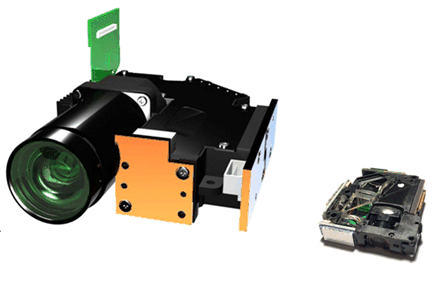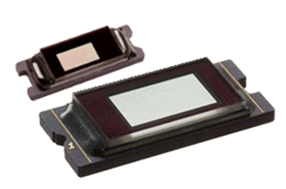DLPA078B February 2017 – September 2021 DLP160AP , DLP160CP , DLP2000 , DLP2010 , DLP230GP , DLP230KP , DLP230NP , DLP3010 , DLP3310 , DLP4710 , DLP471TP , DLPC3420 , DLPC3421
- Trademarks
- 1 Introduction to Optical Modules
- 2 Use Case Considerations
- 3 Core Optical Module Specifications
- 4 Additional Optical Module Specifications
- 5 Features Implemented in Software
- 6 Hardware Integration Considerations
- 7 Business Considerations
- 8 Example Optical Module Specification Table
- 9 Get Started with Development
- 10Revision History
3.2 Size
DLP Pico projection optical modules can vary in size (see Figure 3-1) and can be as small as a few cubic centimeters. The size of a DLP optical module mainly depends on three factors: DMD size (see Figure 3-2), optical design, and illumination size. In general, optical module size increases with brightness capability. Size may be specified with or without a heat sink. There is typically a heat sink on the DMD and one on each LED. The size of the heat sink is mainly driven by the power consumption and efficiency of the illumination in the optical module.
The performance requirements and optical design layout affect both the size and shape of an optical module. Light can be folded (that is, bounced back and forth off mirrors) to minimize a specific dimension such as depth or height. In addition, throw ratio and image offset specifications affect the size of the projection lens. A shorter throw ratio design generally results in a larger size, and a higher offset design generally results in a larger size.
 Figure 3-1 Examples of a 75-mm DLP4501
Optical Module (Left) and a 25-mm DLP2010 Optical Module (Right)
Figure 3-1 Examples of a 75-mm DLP4501
Optical Module (Left) and a 25-mm DLP2010 Optical Module (Right) Figure 3-2 A 0.2" Diagonal DMD (e.g.
DLP2010) Compared to a 0.45" Diagonal DMD (e.g. DLP4501)
Figure 3-2 A 0.2" Diagonal DMD (e.g.
DLP2010) Compared to a 0.45" Diagonal DMD (e.g. DLP4501)